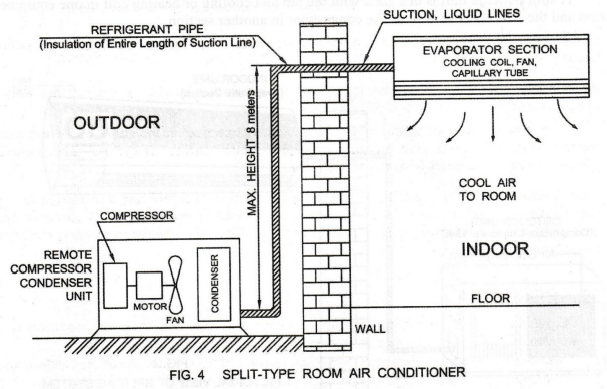Basic Civil & Mechanical Engineering: UNIT V: c. Air Conditioning
Split type Room Air Conditioner
Working Principal, Installation, Layout Diagram, Advantages, Disadvantages
A split package unit is designed with the fan and cooling or heating coil in one equipment section and the condenser as well as the compressor in another section.
SPLIT
TYPE ROOM AIR CONDITIONER
See
Fig. 3. The present trend in the Indian market is to go for the Split Type of
the air conditioning system. It is built in two parts: Cooling Unit and
Condensing Unit and hence the name Split System. Split Type Room Air
Conditioner is also known as Split Package Unit.
A
split package unit is designed with the fan and cooling or heating coil in one
equipment section and the condenser as well as the compressor in another
section.

See
Fig. 4. The cooling unit section is located in the room. The condenser and compressor are placed in a remote location
either indoors or outdoors.

1. COOLING UNIT (INDOOR UNIT)
1. Evaporator Coil and Capillary
Tube
The
High Pressure Low Temperature (HPLT) liquid refrigerant from the condenser is
passed to the capillary tube. . In the capillary tube the refrigerant expands.
The Low Pressure Low Temperature (LPLT) liquid refrigerant then passes to the
evaporator.
2. Evaporator Fan
Evaporator
fan draws air continuously from the inside of the room through an Air Filter.
The air is forced to pass over the evaporator coil by the fan and is cooled by
the refrigerant. Consequently, the refrigerant evaporates by absorbing the heat
from the air.
3. Mounting of Cooling Unit
Cooling
unit may be floor mounted, wall mounted or ceiling mounted, depending on the
requirement.
4. Controls
When
a controlled atmosphere is required in air conditioning, the humidity of the
air is varied. When dry air is required, it is dehumidified by cooling or by
dehydration. In the latter process, the air is passed through absorptive
chemicals such as silica jel. Air is humidified by circulation through water
sprays.
2. CONDENSING UNIT (OUTDOOR UNIT)
1. Compressor
High
temperature evaporated refrigerant from the evaporator is drawn by the suction
of the compressor. The compressor compresses it and delivers it to the
condenser.
2. Condenser Coil
The
condenser can be air cooled in the case of room air conditioner or water cooled
in the case of centralized air conditioner. If a water cooled condenser is to
be used, the condenser is provided with connections for either city water or
well water. For an air cooled condenser, these connections are not required.
3. Condenser Fan
The
condenser fan draws the atmospheric air from the exposed side. The High
Pressure High Temperature (HPHT) refrigerant passing inside the condenser
condenses by giving-off the heat to the atmospheric air.
To
avoid any flashing of liquid refrigerant, a receiver in the liquid line is
recommended, where the distance between the condensing unit and cooling unit
exceeds eight meters.
3. INSTALLATION
There can be a number of combinations for the
installation of cooling and condensing units, depending on the location and
site. However, the following three combinations are very common in practice:
•
Cooling unit and condensing unit at same level
•
Cooling unit being at higher elevation than condensing unit and vice versa.
Combination-1:
This is similar to a unitary air conditioning system with extended suction and liquid
line.
Combination-2:
Normally, the maximum recommended height of the cooling unit when compared to
the condensing unit is 8 meters.
Moreover,
it is advisable to provide a suction line riser at the outlet of the evaporator
to prevent liquid refrigerant from draining to the compressor during
off-cycles. This would be an additional protection apart from the suction line.
Combination-3:
Here, in addition to the proper selection of liquid line and suction line, an
oil trap on the suction line, near the evaporator outlet should be provided, if
the elevation between cooling unit and condensing unit exceeds 3 meters
However, the recommended elevation is 8 meters maximum.
4. ADVANTAGES
1.
Installation: No constraints on the installation of the split type air
conditioner, as the condensing unit can be located in any remote place.
2. Noise-Free Operation: Noise free operation,
because of remote location of the condensing unit.
3. Wall Opening: No breakage or opening in the
wall necessary.
4. Flexibility of Use: Feasibility of using
multiple evaporators with single condensing unit making its use more flexible.
5. DISADVANTAGES
1.
Split Package Unit: Split type is a split package unit and not a single package
self-contained unit.
2. While it is true that the Split System
offers outstanding user conveniences, it is necessary to be aware of the
disadvantages also. These can be counter-balanced by the following actions:
• Usually a drop of 5-10% in capacity is
observed in the split system due to the extended system tubing, when compared
to that of the Window unit. This loss in efficiency would be compensated
partially by selecting suitable sizes of the system tubes.
The
other part of the loss can be taken care by increasing the air flow using four
pole motor for the condenser fan resulting in lower discharge pressure.
• Split
system has lot of joints. It is prone to refrigerant leakage. To avoid this
problem, it is becoming a common practice to eliminate these joints by brazing
the system tubes at the site. The unit is then evacuated and charged in the
installed condition itself.
6. WINDOW AIR CONDITIONER Vs SPLIT- TYPE AIR CONDITIONER
Comparison
of window air conditioner with split-type air conditioner is explained as
follows:

Basic Civil & Mechanical Engineering: UNIT V: c. Air Conditioning : Tag: : Working Principal, Installation, Layout Diagram, Advantages, Disadvantages - Split type Room Air Conditioner
Related Topics
Related Subjects
Basic Civil and Mechanical Engineering
BE3255 2nd Semester 2021 Regulation | 2nd Semester EEE Dept 2021 Regulation
